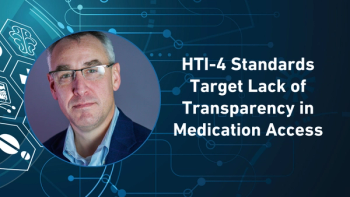
An Economic Path Forward: Thoughts on an Industry Inflection Point
The life sciences industry is at an inflection point, with pressures around pricing, patient access, and affordability converging with the cost of increasingly complex and personalized medicines to make today’s economics unsustainable. Scott Howell and Ray Pressburger discuss what can be done to help solve these challenges across the industry.
The life sciences industry is at an inflection point, with pressures around pricing, patient access, and affordability converging with the cost of increasingly complex and personalized medicines to make today’s economics unsustainable. As a result, stakeholders across the healthcare ecosystem feel the burden of this inefficient marketplace. Out-of-pocket costs for patients have risen dramatically and it’s increasingly challenging for patients to access the medicines they need. Physicians are forced to waste time and resources fighting restrictive formularies, payers increasingly struggle to manage population costs, and profitability pressures are at an all-time high for biopharma companies.
There has to be a better way. Scott Howell, chief strategy officer, US pharmaceuticals, at Novartis, and Ray Pressburger, managing director at Accenture, explore this topic and discuss the realities of today’s marketplace, how we got here, and what can be done to help solve these challenges across the industry.
Healthcare’s 'War of All Against All'
Over the past several years, innovation in the life sciences industry has increasingly shifted toward specialty medicines that are aimed at smaller and smaller patient populations. This shift has become so pronounced that a recent analysis completed by Accenture1 found that more than half of biopharma revenues now come from products of this nature and that such products will drive over 80% of biopharma growth through 2026. However, this has come with a price tag—higher development costs have led to higher list prices, leading payers to demand ever-higher rebates and expand their use of drug utilization management techniques. In turn, manufacturers have responded by increasing investment in programs that support patient access and so on and so forth. This ever-escalating situation can best be described as a veritable “war of all against all,” where manufacturers continue to raise prices and find ways to overcome payer utilization management, while payers constantly look for new ways to contain those costs. This makes today’s economics unsustainable, with our system becoming one that encourages and relies on high drug list prices, extensive opaque rebates that are generally not passed through to patients, and substantial administrative and cost-sharing barriers that can even apply to the appropriate use of medicines by patients. The result? All stakeholders suffer—patients, physicians, payers, and biopharma companies.
A recent study published in Health Affairs2 quantified the economic burden of drug utilization management on the US, reporting that patients, physicians, payers, and biopharma companies together incur approximately $93.3 billion in annual cost implementing, contesting, and navigating drug utilization management. For physicians, annual spending was estimated to be $26.7 billion, owing to physician and physician staff time spent interacting with payers, especially in navigating prior authorization requirements. For patients, it was estimated that $35.8 billion is spent annually on cost-sharing that can be attributed to drug utilization management.
Of course, this is bigger than just the numbers. It is about the real impact on our healthcare system’s ability to serve patients. Physicians and nurses are leaving the practice of medicine in part as a result of stress, burnout, and frustration in an inefficient and counterproductive system at a time when we’re facing shortages throughout the healthcare system. Similarly, a recent patient a survey3 found that patients aren’t filling their prescriptions because they can’t afford them, and their health is suffering.
Navigating these complexities from within life sciences
This all leaves little doubt that the life sciences industry is at an inflection point. Biopharma companies are navigating this “war of all against all” while the structure of the ecosystem and their customers are changing—payers and pharmacy benefit managers (PBMs) are continuing to consolidate, retail pharmacy and trade models are shifting, physician offices are being acquired by hospitals, and regulatory landscapes are in constant flux. As a result, research from Accenture’s report, New Science: A new economic reality for innovation and growth,4 suggests a declining margin in nearly every therapeutic area, including oncology, over the next five years. As a result, there may be less investment in areas of high and broad unmet need with lower margins. For instance, although cardiovascular disease remains a leading cause of death, accounting for one in three deaths in the US, investment in this space has been declining. FDA-related approvals declined 33% between 2000 and 2009, while the number of Phase I studies saw a similar decline between 1990 and 2012.
But what if we could find opportunities to redefine manufacturers’ economic relationships with customers, tailoring access strategies to the unique challenges of a specific asset, market, and customer? This question has been explored and discussed across the industry before, but there is no doubt that new models are required for pricing, access, and affordability to help alleviate pressure quickly while delivering improved patient outcomes.
A path forward
As an ecosystem, incentives need to be rebalanced and realigned to center around patient affordability and access. Novartis has proposed at least one market-based path forward that could serve as an alternative to the current list price, rebate, and utilization management arms race, which they call “value-based price for value-based access.”
In this model, individual manufacturers voluntarily set prices with reference to benchmarks proposed by independent health technology assessment (HTA) organizations. These value-based prices are then linked with value-based access, where individual payers enable better use of these medicines by patients who need them. In practice, this could include rapid formulary review and addition, simple prior authorizations, no step-edits behind products that are not priced in accordance with their value, and low patient cost-shares. Such an approach would benefit all stakeholders—patients would have easier, more affordable access to the medicines they need; providers would spend fewer hours navigating insurer requirements; payers would also pay less for drugs and need fewer systems to manage access; and biopharma companies would be able to focus their resources on developing innovative treatments that address meaningful unmet needs.
These ideas are broad enough to be applied to any kind of medicine, any kind of patient, and any type of insurance coverage. Of course, value-based price for value-based access is just one proposed path of many being explored across healthcare that will help alleviate the pressure within the industry. What is critical is that we collectively push forward new models with conviction and a genuine intent to provide improved healthcare for patients across the ecosystem. Moreover, no single stakeholder can drive this shift alone—nor are they incentivized to do so. Creating real change within the sector will require a multistakeholder effort, and it will take courageous healthcare leaders willing to come to the table, listen openly to others, and chart a new course focused on access, outcomes, and innovation. If done effectively, the opportunities to help redefine medicine are immense.
Ray Pressburger is Managing Director, Life Sciences Strategy at Accenture. Scott Howell is Chief Strategy Officer, US Pharmaceuticals, at Novartis.
References
https://www.accenture.com/_acnmedia/PDF-155/Accenture-Biopharmas-New-Economic-Reality-For-Growth.pdf https://www.healthaffairs.org/doi/full/10.1377/hlthaff.2021.00036 https://www.accenture.com/us-en/insights/health/digital-adoption-healthcare-reaction-or-revolution https://www.accenture.com/_acnmedia/PDF-155/Accenture-Biopharmas-New-Economic-Reality-For-Growth.pdf#zoom=40
Newsletter
Stay ahead in the life sciences industry with Pharmaceutical Commerce, the latest news, trends, and strategies in drug distribution, commercialization, and market access.




